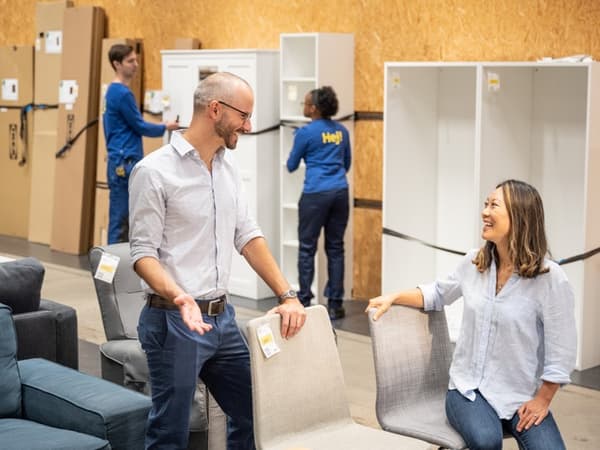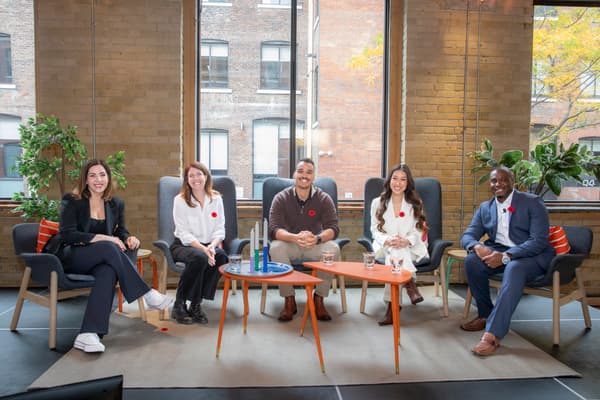Doing More With Less: Part 3

IKEA Canada's vision is to create a better everyday life for the many people, and naturally, great design, quality, and affordability are key. But what does “affordability” really mean? Last fall, Selwyn Crittendon, CEO and Chief Sustainability Officer at IKEA Canada, gathered some of Canada’s top finance experts to discuss what it means to do more with less.
Panel guests included moderator Bianca Freedman, Chief Executive Officer at Edelman Canada; Shannon Lee Simmons, founder of the New School of Finance and personal finance writer for the Globe and Mail; Nathan Kennedy, content creator and host of the podcast “New Money with Nathan Kennedy,” and Rachel Wong, co-founder of Monday Girl, Canada's leading network for professional women.
If you’ve never heard the term “circular economy,” it’s likely just a matter of time. In a circular economy, nothing goes to waste, thanks to the democratic design principles of “reduce, reuse, repair, and recycle.” Scandinavian countries like Sweden are leaders in the circularity movement, and since IKEA is to Sweden what the Allen key is to unassembled furniture, our target of full circularity by 2030 only feels natural.
Talk to IKEA CEO Selwyn Crittendon, and you’ll hear a man on a mission. “It's not just about selling products,” he says. “It’s ‘what happens to those products at the end of their life?’ Do they have a second home to go to? Are they put back into a circular economy? I've been on this journey to really look at things full circle.” It’s the spirit behind the recent ‘Second-Hand Tax,” or “SHT' ' initiative from IKEA Canada, that saves customers from paying tax twice. The SHT initiative lets customers make sustainable choices and save money— talk about win-win!
The topic gets Bianca Freedman fired up, in a good way. “This idea of repurposing furniture and things having a second life—it’s near and dear to our hearts,” she says, speaking on behalf of the panel. Circularity, says Freedman, is the “cultural pulse” of IKEA. As Crittendon explains it, circularity is a multi-step process. Sure, there are the no-brainers, like finding hidden gems in the As-is marketplace at IKEA—both in person and online, trading in your used BESTÅ for an EKET via the Sell-Back program, and working with IKEA partners like the Furniture Bank to help keep goods out of landfills. But that’s just the tip of the iceberg. “We have to be better as a company,” asserts Crittendon. “We have to make sure we build furniture and furnishings that are sustainable and that have a good mission —and a good story—behind them.” By that he means furnishings that—at the end of their life— don’t hurt the planet.
Nate Kennedy has a lot to say about the secondhand economy— after all, he’s been shopping at the As-is marketplace since he was a kid. “Growing up we didn't have too much,” he explains. “A lot of it was secondhand—it’s all I knew.” In university, Kennedy’s sustainable spirit inspired a nice side hustle flipping couches on Craigslist and Kijiji. “You can find some high, high-quality used stuff,” he says. Besides, says Kennedy, “you can talk about ‘luxury’ this and that– but at the end of the day, is it a great piece? Does it look good? Is it functional, and is it at a good price point?”
From a personal finance viewpoint, the circular economy can help Canadians save money. Many families buy items off Facebook marketplace expressly to resell them and buy something else. But ironically, the time and energy it takes to live cheaply can be a huge barrier to access. “We all know the tips,” says Shannon Lee Simmons of the thrifting spirit. “We’ve all watched the shows. But doing it takes time, energy, and bandwidth that not everyone has.” Unfortunately, being squeezed for time feeds into Canada’s credit card habit because “it’s the fastest way to get what you need when you only have fifteen minutes.”
Lee Simmons says the secondhand economy must be convenient to be viable. She cites the IKEA Sell-back program as a successful model. “It's one place where you can bring something —and buy something that's also affordable—all in one space.”
Kennedy would like to see more and more companies remove the taboo and stigma around buying secondhand or As-is stuff. “It really speaks to Canadians,” he says. Crittendon couldn’t agree more and challenges Canadian business owners to band together. “IKEA alone can't make this happen,” he says, noting that SHT is only a temporary solution. The good news is anyone can show support for ending the double tax on second-hand items by visiting change.org (35,120 signatures and counting!) and signing the petition. “For me, this is a call out,” says Crittendon. “How do we do this together? How do we build the infrastructure, the knowledge, and the commitments together? Then we'll make a difference.”
In our next and final post, we’ll discuss how businesses can best support co-workers and local communities to live more fulfilling lives.
